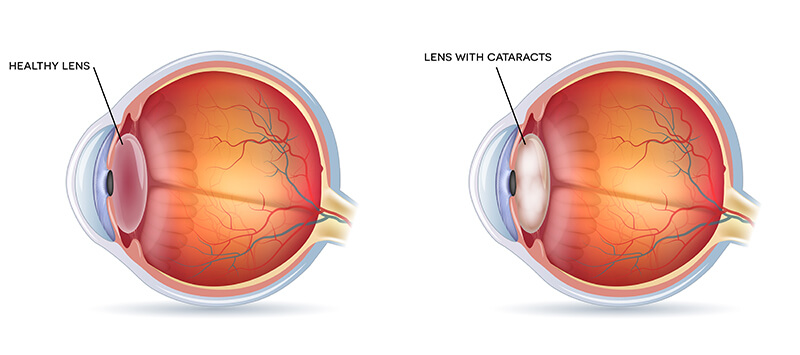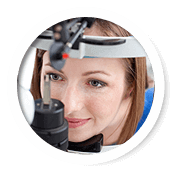What is a Cataract?
A cataract is present when the lens of the eye becomes cloudy. The lens is located behind the iris, which is the colored part of the eye. The lens helps focus the rays of light coming from an object to form an image on the retina located at the back of the eye.

About Cataracts
More than fifty percent of people over 60 years of age suffer from cataracts. Looking through a cataract is similar to looking through a window that is frosted or fogged with steam.
Common symptoms include painless blurring of vision, need for brighter lights to read, glare or light sensitivity, double vision in one eye, fading or yellowing of colors, and frequent eyeglass prescription changes.

What Causes Cataracts?
The most common cause of a cataract is aging of the eye. Other causes or risk factors include family history, medical problems such as diabetes, smoking, injury to the eye or previous inflammation, and long term use of steroid medications. A cataract cannot be caused by overusing the eyes. This is a common misconception.
How is a Cataract Treated?
Currently there is no medical treatment shown to reverse or prevent cataracts. However, sunglasses that filter out ultraviolet light rays or regular glasses with a clear anti-ultraviolet coating may help prevent or slow the progression of cataracts.
In the early stages, stronger glasses can usually partially compensate for blurred vision from a cataract. When you feel that the cataract is starting to interfere with your quality of life, it is time to consider surgery. The decision to proceed with surgery is yours and depends on your daily activities and your lifestyle
Types of Implantable Lenses
Cataract Surgery involves removal of the cataract and replacement with an artificial intraocular lens (IOL) that can restore clear vision. Many of the steps traditionally performed with a blade can now be performed with laser-precision using the Catalys® Laser System. Dr. George Khouri can provide you with a highly customized, more precise and gentle approach to cataract surgery. Dr. Khouri can also discuss options to produce your best visual outcomes using different Lifestyle Lens Implants.
Cataract Treatment with Astigmatism or Presbyopia
Two aspects of cataract treatment need to be considered: astigmatism if present, and presbyopia in order to achieve reduction or independence from glasses for distance and/or near:
The first aspect is astigmatism which is an irregular curvature of the cornea because it is shaped like a football instead of a basketball. When light enters the front part of the eye, this corneal irregularity bends and focuses light in one direction more than another which can lead to a blurred, distorted image on the retina. This condition can be treated with the CATALYS® Laser System which creates corneal arcuate incisions placed strategically to address the corneal irregularity. Depending upon the severity of your astigmatism, another option for correcting the astigmatism would be to use a Toric Lens Implant.
The second aspect is presbyopia, which can be treated with Multifocal Lens Implants or Accommodative Lens Implants.
What to Expect at a Cataract Consultation
 Cataract diagnosis is part of a comprehensive eye exam, and you should schedule an appointment as soon as you notice cataract symptoms. Our ophthalmologist will discuss your medical history and ask about vision changes. A series of tests determine cataract formation by doing the following:
Cataract diagnosis is part of a comprehensive eye exam, and you should schedule an appointment as soon as you notice cataract symptoms. Our ophthalmologist will discuss your medical history and ask about vision changes. A series of tests determine cataract formation by doing the following:
- Testing for Visual Acuity: The standard eye chart is used to measure your ability to read letters of various sizes by covering one eye at a time. Visual acuity tests establish how well you see, diagnose refractive errors and identify vision impairment.
- Testing for Intraocular Pressure: An applanation tonometry test measures the intraocular pressure of each eye to detect abnormally high or low fluid pressure in the eyes.
- Slit-lamp Examination:The slit lamp is used to view the structures in the front portion of your eye and magnify them. An intense stream of light (or slit) brightens the cornea, iris and the space in between. The pupils are then dilated with drops to examine the natural eye lens. Changes in the lens help to identify signs of a cataract. A slit-lamp examination helps our eye doctor focus on each eye structure to diagnose eye diseases and conditions based on tiny abnormalities in these areas.
- Examining the Retina: When your pupils are dilated, our eye doctor examines the back of your eye, where the light-sensitive retinal tissue is located, using a special device called an ophthalmoscope.
After your eye exam at Palm Beach Eye Center, Dr. Khouri will discuss your cataract treatment options. Cataracts can progress slowly, and some people choose to wait for cataract surgery until they experience significant vision impairment from the clouded lens, while others wish to eliminate the cataract as soon as possible. Our eye doctor can answer your questions during this time and help you determine when it is time to consider cataract surgery.
When electing to have surgery, you will be asked to choose whether you would like to have the cataract removed using the traditional manual technique or the more advanced laser cataract surgery technique. You will also be asked to select the type of lens implant you would like for Dr Khouri to use depending on your needs.
How Much Does Cataract Surgery Cost?
Insurance providers typically cover most of the cost of cataract surgery. That coverage includes manual cataract surgery and replacement of the natural eye lens with a monofocal lens implant adjusted to correct your vision at one focal point, typically distance. However, many patients wish to have laser cataract surgery instead of traditional manual cataract surgery. They may also choose to decrease their dependence on prescription eyeglasses and contact lenses by getting lifestyle lens implants. These advanced implants can address refractive errors, including nearsightedness, farsightedness, astigmatism and presbyopia (age-related blurry near vision). Insurance coverage for cataract surgery doesn’t include laser cataract surgery or lifestyle lens implants, but our office can help you with financing options.
How Do I Know If I Need Cataract Removal?
 Many people need cataract removal when cloudy eyes significantly impact their vision and quality of life. You may have severely blurry eyesight and difficulty seeing in dimly lit environments or driving at night. Advanced cataracts can cause light sensitivity and glare or halos around lights, and colors may appear muted or have a yellowish overlay. Frequent prescription changes are another warning sign that you may need cataract surgery soon.
Many people need cataract removal when cloudy eyes significantly impact their vision and quality of life. You may have severely blurry eyesight and difficulty seeing in dimly lit environments or driving at night. Advanced cataracts can cause light sensitivity and glare or halos around lights, and colors may appear muted or have a yellowish overlay. Frequent prescription changes are another warning sign that you may need cataract surgery soon.
While these symptoms indicate an already advanced cataract, many people choose to have the procedure earlier on to enjoy the benefits of lifestyle lens implants. Earlier cataract surgery may improve recovery time, and patients can avoid significant vision changes from worsening cataracts.
If you are considering cataract surgery, contact us today and schedule an appointment with Dr. Khouri to discuss your treatment options.









